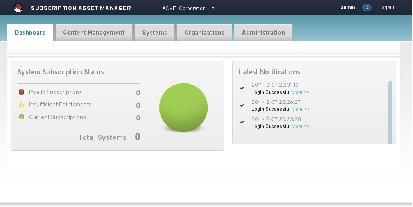Subscription Asset Manager (SAM) Quick Start Guide
Environment
- Red Hat Enterprise Linux 7.0 and later releases
- Red Hat Enterprise Linux 6.1 and later releases
- Red Hat Enterprise Linux 5.7 and later releases
- Subscription Asset Manager (SAM) 1.4 installed on Red Hat Enterprise Linux 6.6 Server, 64-bit architecture (x86_64)
Issue
- How do I get started with Subscription Asset Manager (SAM)?
Resolution
WARNING: Subscription Asset Manage reached it's End of Life on October 31st, 2018.
Installing SAM at this point still receives support until that date, but it is highly recommended to use an alternative method to manage your system subscriptions.
Planning: Network topology
- LAN or vLAN connection is recommended between SAM and managed RHEL systems
- Access to secure http ports 443 and 8088 is required
- See details on above and other prerequisites (such as disk space) in official documentation - Installing Subscription Asset Manager

Planning: Enhanced Reporting
- Enhanced Reporting is a new feature available as of SAM 1.3, there are 2 options - fully supported (SAM integrated with Red Hat Satellite 5.6), or tech review (SAM stand-alone).
- Fully supported option: generating a cross-service report with Red Hat Satellite 5.6 and Subscription Asset Manager 1.3+. The Red Hat Satellite 5.6 server needs to be installed first before installing the SAM server - please stop here and refer to Satellite documentation for installation instructions for both.
- Tech preview option: used solely to generate reports on Subscription Asset Manager organizations - follow "Install SAM" section below then refer to Installing Packages for Enhanced Reporting.
Install SAM
-
Install Red Hat Enterprise Linux 6.6, 64-bit architecture (x86_64).
- Although SAM can manage subscriptions on RHEL 5, RHEL 6, and RHEL 7 clients, the application itself requires RHEL 6.6 to run
-
Subscribe using either Red Hat Subscription Management or Red Hat Network (RHN) Classic. Red Hat Subscription Management is recommended.
-
If installing from ISO, see Installing Through an ISO Image
-
If using Red Hat Network (RHN) Classic, add "SAM for RHEL Server (v. 6 64-bit x86_64) " channel sam-rhel-x86_64-server-6.
-
If using Red Hat Subscription Management, start subscription-manager, see Installing Using yum
-
Register the SAM host system with --autoattach option (wait a few minutes for it to complete adding content repositories)
subscription-manager register --auto-attach -
Run the following command to enable the rhel-6-server-sam-rpms repository and disable Enhanced Updates (EUS) repository
subscription-manager repos --enable rhel-6-server-sam-rpms --disable rhel-server-rhscl-6-eus-rpms -
Then, install Subscription Asset Manager using
yum install -y katello-headpin-all -
Then, configure Subscription Asset Manager (see Additional Examples of the Configuration Script for options to override default values or populate from answer file) with following command (the --org option is not required but helpful to set to the name of the initial organization name for your deployment, otherwise it defaults to "ACME_Corporation")
katello-configure --deployment=sam --org=Name_of_Your_Org --user-pass=Your_Admin_Password
-

Subscription Manifest
- Log into Customer Portal:
Select Subscriptions->Overview
Click on Subscription Management
Click on Register under Subscription Management Applications
Choose Subscription Asset Manager Organizations in dropdown and enter the name of the Organization from above SAM install
Attach subscriptions
Download manifest- See Managing Manifests for Organizations in the Importing and Maintaining Manifests section for details on generating/downloading the Manifest from the Red Hat Customer Portal and uploading the Manifest to SAM

- See Viewing Subscriptions for the Organization for verifying subscriptions in the Organization.
Subscription-manager on managed RHEL systems
-
Verify that subscription-manager is installed and updated to the newest version
- RHEL 5.7, 5.8, 5.9, 5.10, 6.1, 6.2, 6.3, 6.4, and 7.0 are supported
-
Required Upgrades
-
A new model of pricing and counting subscriptions were coincident with the Subscription Asset Manager 1.3 release. In addition, SAM 1.4 contains pricing changed in RHEL 7 release. SAM 1.4 (and updated Red Hat Subscription Manager) can properly parse and apply these updated subscriptions as well as the former subscription structure. Older versions of Subscription Asset Manager cannot.
-
See SAM release notes - SAM 1.4 Release Notes
-
-
Review Systems and Subscriptions concepts
-
Install the configuration RPM and register system to the SAM server - see Registering a System.
-
Refer to Managing Systems and Subscriptions for instructions to use System Groups, view installed Products for a System, attach and remove Subscriptions, configure and run auto-attach.
This solution is part of Red Hat’s fast-track publication program, providing a huge library of solutions that Red Hat engineers have created while supporting our customers. To give you the knowledge you need the instant it becomes available, these articles may be presented in a raw and unedited form.


Comments